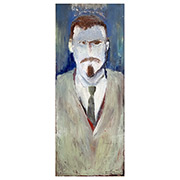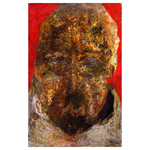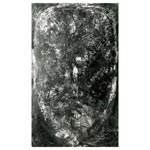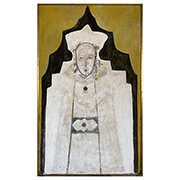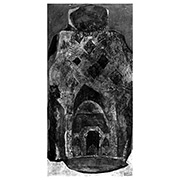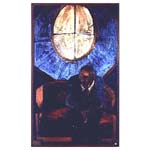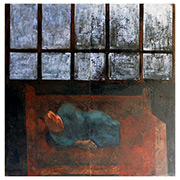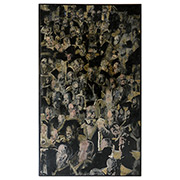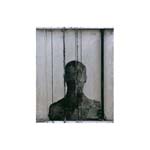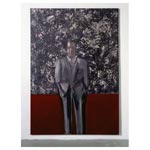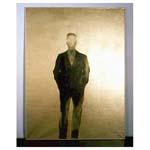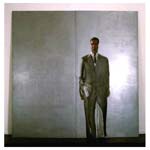Pistoletto showed his work for the first time in December 1955, a self-portrait executed the same year that was included in an exhibition at the Circolo degli Artisti in Turin, the place where his father often presented his own paintings.
In 1956 he rented his first studio, an attic on Via Bava, where he carried out his artistic research, focusing more and more on the self-portrait and producing works with a strong material impact and verging on the nonrepresentational, in which a frontal view of his face occupied the entire surface of large canvases. Good examples of this, among the surviving works from that time, are Self-Portrait [Autoritratto] (1956) and Self-Portrait [Autoritratto] (1957) and a self-portrait from 1956 of which the original was destroyed but whose photographic reproduction on a 1:1 scale was subsequently exhibited under the title Current Self-Portrait or Timeless Self-Portrait.
Some works produced between 1957 and 1958 are of particular significance in the evolution of his work. Church [Chiesa] (1957) and The Temple [Il tempio] (1958) are paintings of large size whose surface is once again occupied almost totally by a human face or body, but whose features in these works are formed by the typical architectural elements of a place of worship. Priest [Sacerdote] (1957) and The Saint [Il santo] (1957) present two people, again from the front but almost full length, in hieratic poses and draped in holy vestments. In Priest the geometry of the stylized figure recalls the pointed structure of a Gothic cathedral and is also set against the gold ground typical of religious icons.
All four of these works were reproduced in the magazine Presenze, published in Turin between 1957 and 1960 by a group of intellectuals and artists made up of Pistoletto himself, his photographer friend Renato Rinaldi, a fellow student at the commercial art school, and Marzia Calleri, Pistoletto’s first wife whom he had married in 1955, and who, like Rinaldi, would be the subject of many of his early Mirror Paintings.
It was in the same magazine that Pistoletto published his first two writings, in which he reflected on the value of abstract art, on the stalemate in which it found itself at the time, on the danger of its reduction to a sterile formalism and on the importance of reviving the essential social and spiritual function of art.
In November 1958 he entered and won the “Premio San Fedele” competition in Milan. Luigi Carluccio, a member of the jury and an authoritative and influential Turinese critic and curator, introduced him to Mario Tazzoli, proprietor of the Galleria Galatea, a renowned gallery in Turin that in those years was showing the most advanced research in the field of figurative art, including works by people like Bacon, Balthus and Giacometti. Tazzoli offered him an exclusive contract with his gallery. So Pistoletto closed the advertising agency, left the studio on Via Bava and acquired a new and larger workspace adjacent to his home on Via Cibrario.
In some of the paintings the figure passed from occupying the whole canvas to assuming tiny dimensions with respect to the setting in which it was located, for example under the large vault of a cathedral or behind an enormous table.
He was progressively focusing his research on the relationship between the human figure and the background, incessantly trying out different solutions. Particularly significant in this sense are Man on Sofa [Uomo sul sofà] (1958) and Man Sleeping [Uomo che dorme] (1958). Both present a human figure, seated or lying, with a luminous stained-glass window radiating light from behind. Unlike the ones present in some of his earlier paintings, which had the typical lozenge shape of church windows and performed a secondary and principally decorative function, the windows in these two works take up almost half the picture, becoming an important source of light and, in the case of the large one in Man Sleeping, dropping all reference to religion or transcendence.
Significant for the evolution of the relationship between figure and ground are two works executed between 1958 and 1959, The Crowd [La folla] and The Ungrateful Crowd [La folla ingrata]. The title of the latter in Italian, La folla ingrata, is an untranslatable play on words, as ingrata means “ungrateful,” but in grata means “inside a grating.” In these two works the representation of his own face, through which Pistoletto had begun to look for a personal existential and artistic identity, is broken down and multiplied into a crowd of faces that stand out from a dark background and occupy the entire surface of the picture. To accentuate the character of depersonalization and alienation already usually associated with the idea of the crowd, Pistoletto in The Ungrateful Crowd imprisoned the mass of faces in a grid of lozenges that recalls a grating or a cage. It is in this last work that a theme that would be recurrent in Pistoletto’s work appears for the first time: the cage, subject of many Mirror Paintings and other works. In fact the cage represents, succinctly, the dialectical opposite of the opening constituted by the discovery of the Mirror Paintings.
Significant too, among the works produced in 1959, is Experiment 59 [Esperimento '59], in which the figure is reduced to a simple silhouette of the shadow cast on the canvas by the artist and the background to a monochrome silver, a solution that appeared for the first time in this painting.
“Between 1956 and 1958 I made the portraits, which became larger and larger over time, with a head that got bigger and bigger [...]. Later, the heads got smaller to leave room for the body and the surrounding space. In this reduction of the figure to life size I was helped a lot by Bacon’s show at the Galatea [held in January, 1958]. Seeing Bacon I perceived that my problem and my drama were already there, made explicit, in a man in search of his own dimension and his own space, an impenetrable glass cage, in which the man lived in a state so dramatic it suffocated him, deprived him of voice and space. He was blocked, hunted, sick, destroyed, anguished—splendidly painted but, in this state, terribly isolated [...]. I continued my inquiry, honing my work in on man, but seeking to do just the opposite of what Bacon did: to remove all expression and all movement from the figures in order to cool their drama [...]. I continued to play with the relationship between the mass of this person and his background—which brought me to gold grounds and black grounds. I made backgrounds that wanted to be all light (whence the window), or absolutely automatic and inexpressive backgrounds. They were thousands of little lines or linoleum-like surfaces—that is, anonymous decorative backgrounds—and from this anonymity of the background I expected to see something happen.”
(M. Pistoletto, interviewed by Germano Celant, in Pistoletto [Florence: Electa, 1984], 23).
In March 1960 he held his first solo exhibition, at the Galleria Galatea, in which he showed twenty works executed between 1958 and 1960, including self-portraits, some figures of athletes, landscapes and a still life.
In June 1960 his first daughter, Cristina, was born. She was to embark on a career in the performing arts as a soprano and would collaborate with her father on many occasions over the following decades.
In some of the works produced over the course of 1960 the figure, depicted frontally, standing and life size, dressed in nondescript fashion in jacket and necktie, took on a more and more immobile and inexpressive character, as the prototype of an ordinary human being, while the background, on which the artist was now focusing his attention, passed from the repetition of decorative signs, as in Linoleum Self-Portrait [Autoritratto linoleum], to the monochrome of Bronze Self-Portrait [Autoritratto bronzo], Gold Self-Portrait [Autoritratto oro] and Silver Self-Portrait [Autoritratto argento]. The latter is a diptych consisting of one canvas on which the figure is painted on a silver-colored background set alongside a second canvas taken up entirely by the silver ground, an empty space that seems to anticipate the part of the metallic surface of the Mirror Paintings of the future on which the images of the surrounding space would be reflected.
